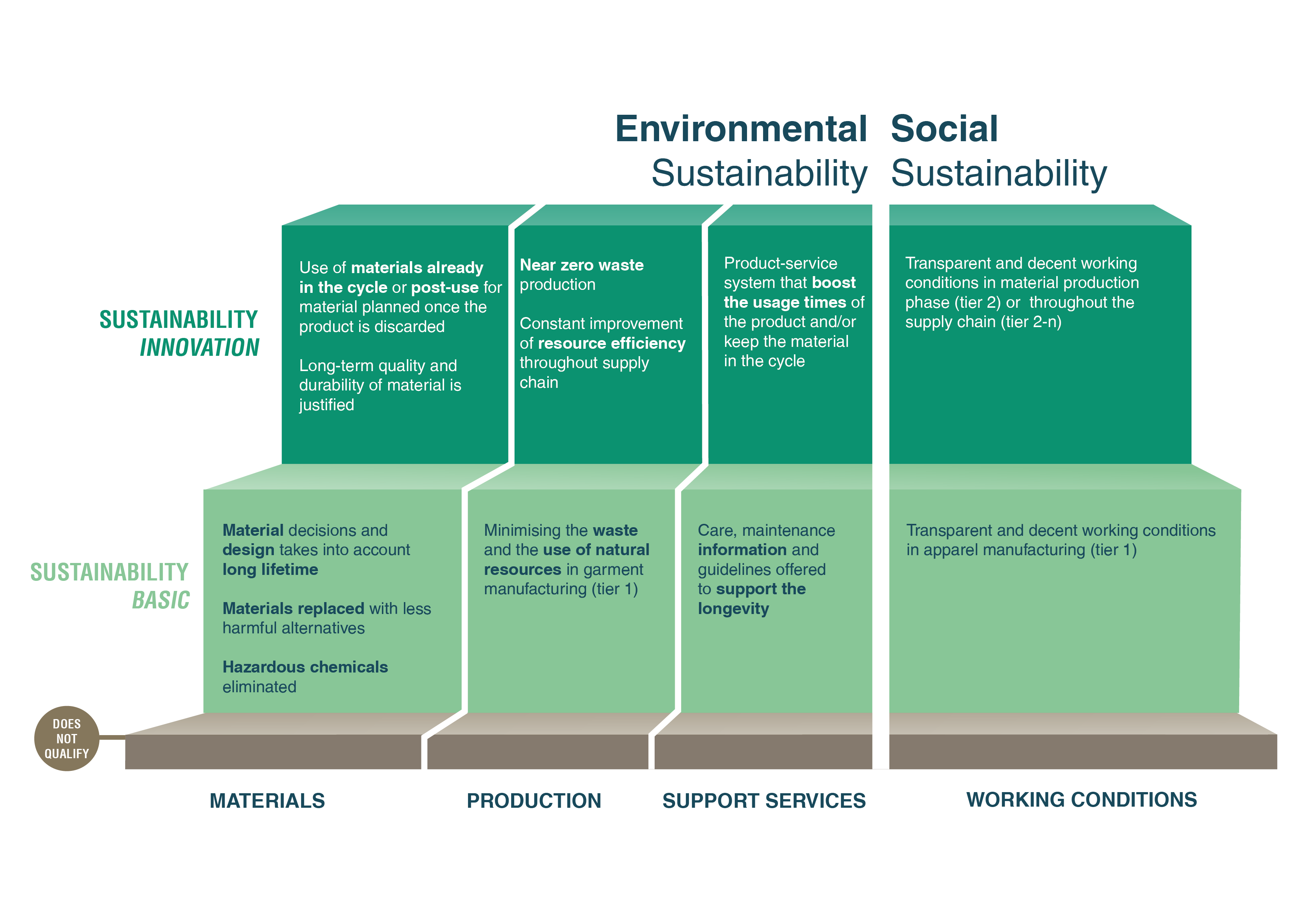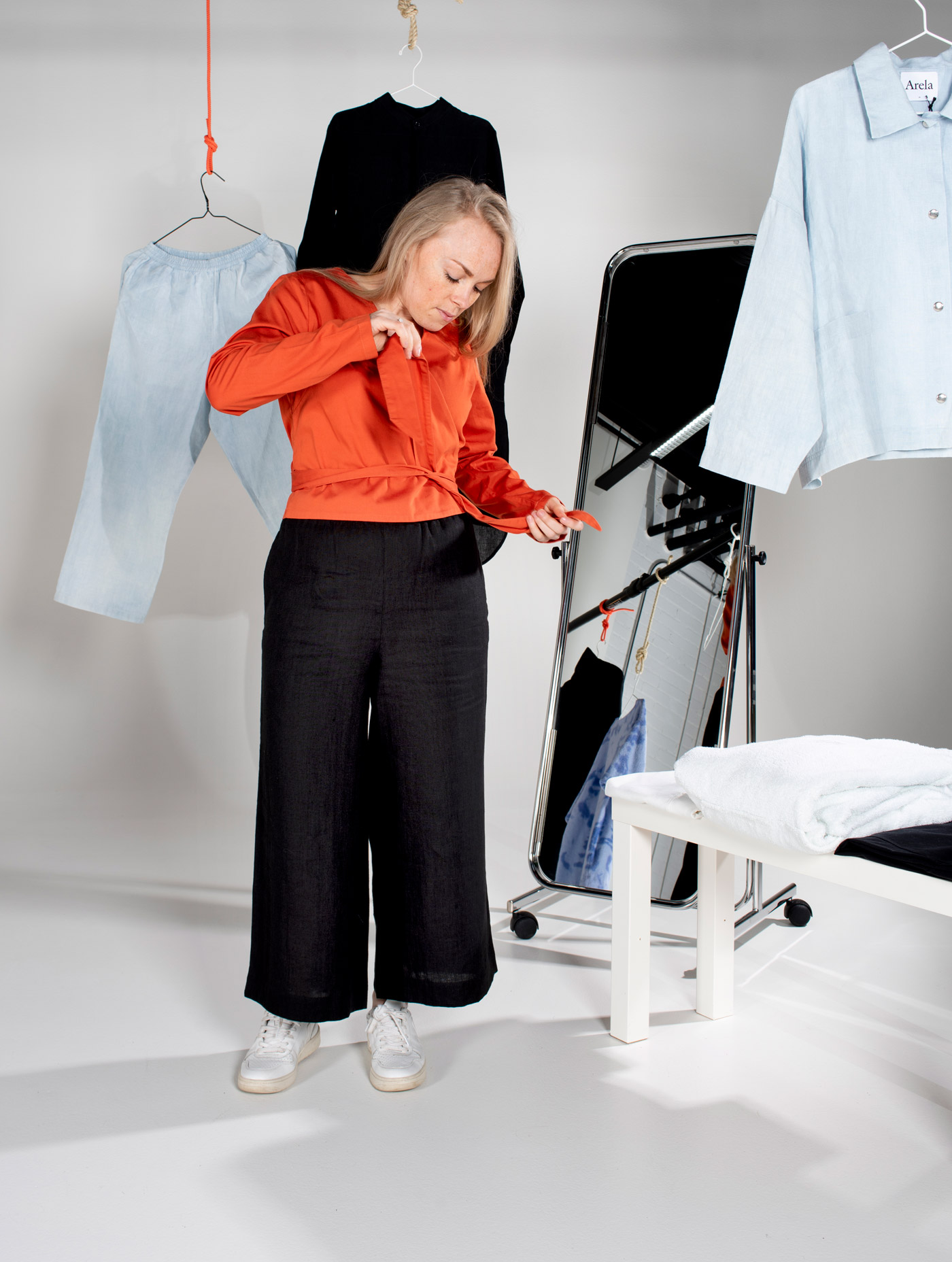ABOUT
An instrument for clarifying sustainability of garments
The aim of the Shades of Green instrument is to offer simple yet comprehensive environmental and social sustainability information of products in an actionable form. The instrument aims to help product-level sustainability communication to consumers, making it easier for them to understand and compare the multi-faceted sustainability aspects of textile and fashion items.
Today, understanding and comparing the sustainability aspects of garments is challenging due to a variety of different third-party verified sustainability labels and free-form sustainability communication. The Shades of Green instrument, being positioned between the two, offers transparent and comparable information, supporting consumers in making more sustainable purchasing decisions.
The instrument encapsulates both the environmental and social aspects throughout a product’s lifecycle focusing on materials, production, support services and working conditions. It has two levels, Sustainability Basic and Sustainability Innovation, demonstrated as a staircase with different shades of green. In order to meet the instrument criteria, companies need to be well on the way of developing the sustainability of their products. Many of the fashion items of today do not qualify for the requirements of the instrument.
The academically rooted Shades of Green instrument has been developed in the FINIX research project on sustainable textile systems by Postdoctoral researcher Linda Turunen and Professor of Sustainability Management Minna Halme.
LOGIC
The two stairs of environmental and social sustainability of a product
The instrument categorizes products into two different levels based on their environmental and social sustainability features. The criteria of these levels emphasize circular economy and the longevity of the product. The criteria at the levels build upon each other. In other words, the requirements at the lighter green level must be met before moving to the darker green level.
This way, it acknowledges the process-like nature of sustainability and encourages companies to strive towards the higher level.

Sustainability Basic
The light green level considers actions that reduce harm in the current fashion system.
From an environmental perspective, this refers to using environmentally preferable raw materials, eliminating hazardous chemicals, and reducing production-related impacts.
From a social perspective, this refers to assuring transparent and decent working conditions in the apparel manufacturing phase.
Sustainability Innovation
The dark green level considers more forward-looking actions that are centered around doing good by providing innovative, highly sustainable solutions.
From an environmental perspective, this refers to using materials already in the cycle and designing for recyclability, improving resource efficiency, applying near zero waste production and offering product-service systems to extend the life-time or boost the usage times of the product.
From a social sustainability perspective, this level requires transparency and assuring decent working conditions not only in the production but also in the materia production phase and pursuits to secure working conditions throughout the supply chain.
DEVELOPMENT
The instrument development process
The Shades of Green instrument development process has included four phases thus far and still continues.
In the first phase, the instrument logic was grounded in previous literature and then refined based on 12 stakeholder interviews with companies, NGOs and experts.
In the second phase, the early version of the instrument was piloted with an online marketplace for sustainable fashion and at the same time, iterative workshops were held with 50 sustainability-oriented consumers and 45 company representatives.
In the third phase, 14 textile and fashion companies of different types were involved in testing the instrument for their products. Results from these preliminary phases are available in an article published in the Journal of Cleaner Production.
During the development process, the true need for a simple yet comprehensive instrument to support sustainability communication towards consumers became apparent, and valuable refining and modification needs and ideas emerged in stakeholder interaction.
We are currently working with the fourth phase, which involves operationalizing the criteria, testing them and refining them further.

All photos by Anne Kinnunen (2021)
FUTURE
Next steps for the instrument
For the Shades of Green instrument to become operational, a number of steps and further testing are needed. The main alternative pathways for implementing the instrument are 1) multi-stakeholder pathway and 2) commercial pathway.
In the multi-stakeholder pathway, the instrument would be hosted by an independent NGO or a network of specialized NGOs. The pathway would include further developing the criteria with international NGOs, academia and businesses, testing with consumers and companies, piloting the instrument, and defining the means of information verification.
In the commercial pathway, the instrument would be hosted by a respective trade association or by a company established for running the instrument management.
CONTACTS
Further information
and inquiries
For further information on the Shades of Green instrument, see the article by Turunen, L. L. M. and Halme, M. (2021) “Communicating actionable sustainability information to consumers: The Shades of Green instrument for fashion”, published in Journal of Cleaner Production, available here.
For inquiries, please contact Linda Turunen with this form at the following email address.
linda.turunen@aalto.fi

